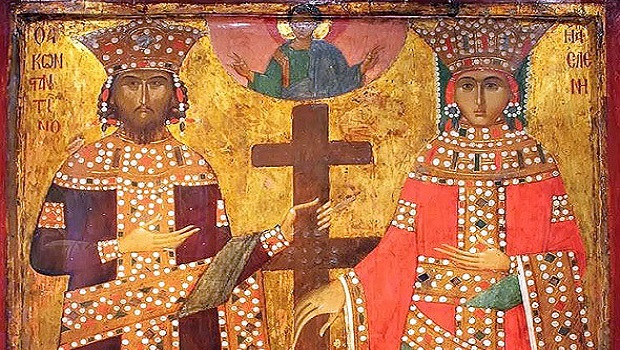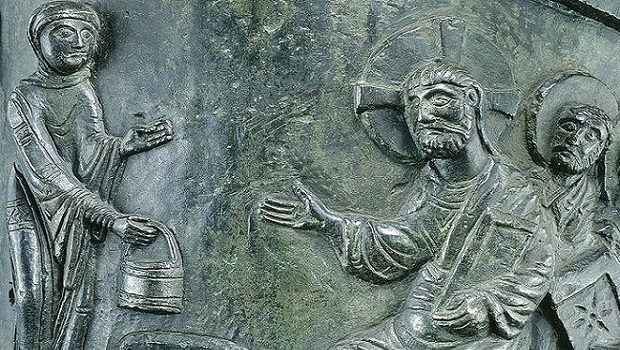Metropolitan of Pisidia Sotirios
The feast of the Holy Protection of the All Holy Theotokos is known throughout the Orthodox world. It is celebrated on October 1st (October 14th on the Old Calendar), and in the Church of Greece on October 28th, to commemorate the protection of Greece during World War II.
The two words alone, “Holy Protection” bring to our mind the maternal love and shelter that our All Holy Mother gives us in times of danger, as well as the unfailing help that she provides in the difficult moments of our lives.
But how did this feast day come to be established on the 1st of October? The historical event behind it is particularly interesting. At the south side of the St. Mary of Blachernae Church in Constantinople, there was a chapel which possessed a reliquary containing the Gown of the Theotokos. In the beginning of the 10th Century, while an All-night Vigil Service was taking place, a saint named Andrew went to take part. St.Andrew, known as a “Holy Fool for Christ” (because he would act in an unusual and foolish way to hide his sanctity) was accompanied by a young man named Epiphanius, who would later become Patriarch of Constantinople. At midnight, St. Andrew saw the All Holy Theotokos entering the church through the main door towards the Holy Altar. She appeared very tall, and was escorted by a bright company of Angels and Saints, all dressed in white. Among them could be seen St. John the Forerunner and St. John the Theologian, on the right and left side of the Theotokos. Some were leading, and others were following in the procession, chanting hymns.
When the Theotokos and her entourage approached the ambo (the pulpit) that was at the center of the church, St. Andrew said to Epiphanius:
– Can you see the All Holy Mother and Lady of the world?
– Yes, honorable father, replied the young man.
While this was taking place, the Theotokos had fallen to her knees and prayed for a long time. She was pleading with her Son to save the world, wetting her holy face with tears. After her supplication, she entered the Holy Altar, where she prayed for the faithful who were keeping vigil. When the All Holy Theotokos finished her prayer, she modestly removed the bright maphorion (the red shawl that we see in icons of the Theotokos which cover her head and body) and as it was so large, she spread it over the congregation, sheltering them with her precious hands. This is how the two of them saw it, radiating with divine glory like amber. For as long as the Lady Theotokos was visible, the maphorion was also beaming. When the Theotokos returned to Heaven, the Shawl also started slowly shrinking and then disappeared.
It is this and other miracles associated with the holy Shawl of the Theotokos that resulted in the establishment of the feast of the Holy Skēpe, the Protection that the All Holy Theotokos provides to all who, with faith, invoke her grace.
The miracles of the Holy Protection of the Theotokos are without number. When Constantinople was once surrounded from the sea by enemy ships, it is said that the Patriarch took from the Blachernae church the holy Shawl of the Theotokos, and dipped it into the sea. This immediately caused a great storm to rise, resulting in the sinking of many enemy ships, with the surviving ships fleeing in panic. In more recent years, during the Second World War, Greek soldiers in their trenches saw many times the Theotokos protecting them from enemy fire.
How often has the Theotokos sheltered and protected us in times of danger and need? It is for this reason that Christians should call upon our All Holy Lady, our affectionate Mother, in every moment of pain and want. Seeking her protection with confidence, and filled with gratitude, making our way to Church on her Feast Day, offering thanksgiving as the hymnographer urges us:
Come to honor in all devoutness
The Lord’s Mother’s holy Protection,
The one that provides safe protection to the faithful,
The one which also discharges us of all sufferings and sorrows.
Let us entreat also our All Holy Lady with the words of the hymnographer:
Cover us, Lady, Queen of the world,
With the Grace of Your Protection, the mighty one,
And save from dangers and painful circumstances
Those who honor You devotedly.
May the Holy Protection of our All holy Lady cover, safeguard and protect all of us, and grant peace to the world. Amen.
Source: pemptousia.com




0 Comments